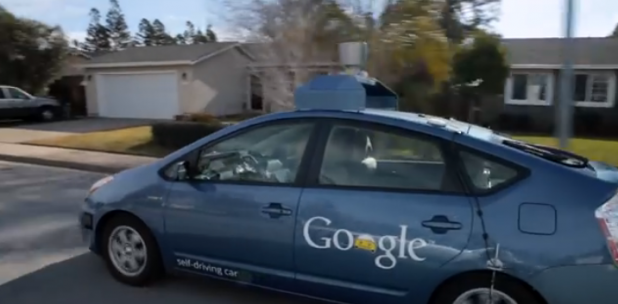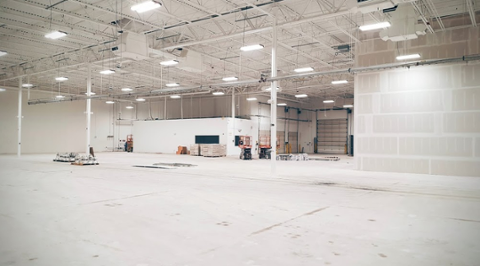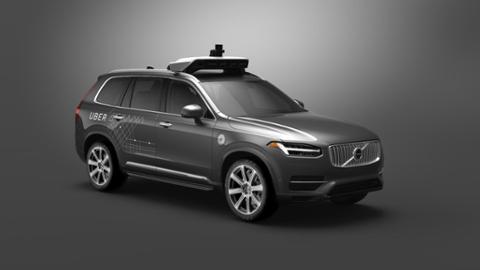 Google's self-driving car, out for a spin.[/caption] Google isn’t the only company experimenting with self-driving cars: Volvo is building 100 autonomous vehicles as part of a pilot program, with plans to test them on roads by 2017. Those road tests will take place near the Swedish town of Goteborg, according to the Associated Press. In theory, the vehicles will have the ability to self-park; and should the human driver want to take the wheel on occasion, the onboard systems will cede control. Google has long categorized its own efforts to build the perfect self-driving car as a “moonshot,” and it remains to be seen whether car companies embrace the technology once it hits the road at some point over the next few years. If self-driving cars become popular, they could—at least in theory—reduce accidents and give people with disabilities greater access to society. At the same time, vehicle sensors sending enormous datasets back to Google and other companies could help improve the cars’ hardware and software, making them still more efficient and safe—a perfect virtuous cycle. But if self-driving cars begin to dominate commercial segments such as trucking and taxicabs, what will happen to all those drivers and other personnel who once made a living off transporting goods and people from Point A to B? Earlier this year, a piece in The New York Times by David H. Autor and David Dorn (titled “How Technology Wrecks the Middle Class”) suggested that replacing human laborers with machines results in economic devastation. “Computers excel at ‘routine’ tasks: organizing, storing, retrieving and manipulating information, or executing exactly defined physical movements in production processes,” the article suggested. “These tasks are most pervasive in middle-skill jobs like bookkeeping, clerical work and repetitive production and quality-assurance jobs.” Those jobs that require quite a bit of situational adaptability but still fall under the “manual labor” category, such as driving trucks, have so far been safe from the disruptive technology advances eliminating many white-collar jobs. But that could change. Once self-driving technology becomes advanced enough to adapt well to the road’s ever-changing conditions, there’s always the possibility that commercial drivers could find themselves replaced by machines—not exactly something that people greet with rapturous applause. While Google, Volvo, and other companies may eventually perfect the digital driver, they could face significant protests in the process. Image: Google
Google's self-driving car, out for a spin.[/caption] Google isn’t the only company experimenting with self-driving cars: Volvo is building 100 autonomous vehicles as part of a pilot program, with plans to test them on roads by 2017. Those road tests will take place near the Swedish town of Goteborg, according to the Associated Press. In theory, the vehicles will have the ability to self-park; and should the human driver want to take the wheel on occasion, the onboard systems will cede control. Google has long categorized its own efforts to build the perfect self-driving car as a “moonshot,” and it remains to be seen whether car companies embrace the technology once it hits the road at some point over the next few years. If self-driving cars become popular, they could—at least in theory—reduce accidents and give people with disabilities greater access to society. At the same time, vehicle sensors sending enormous datasets back to Google and other companies could help improve the cars’ hardware and software, making them still more efficient and safe—a perfect virtuous cycle. But if self-driving cars begin to dominate commercial segments such as trucking and taxicabs, what will happen to all those drivers and other personnel who once made a living off transporting goods and people from Point A to B? Earlier this year, a piece in The New York Times by David H. Autor and David Dorn (titled “How Technology Wrecks the Middle Class”) suggested that replacing human laborers with machines results in economic devastation. “Computers excel at ‘routine’ tasks: organizing, storing, retrieving and manipulating information, or executing exactly defined physical movements in production processes,” the article suggested. “These tasks are most pervasive in middle-skill jobs like bookkeeping, clerical work and repetitive production and quality-assurance jobs.” Those jobs that require quite a bit of situational adaptability but still fall under the “manual labor” category, such as driving trucks, have so far been safe from the disruptive technology advances eliminating many white-collar jobs. But that could change. Once self-driving technology becomes advanced enough to adapt well to the road’s ever-changing conditions, there’s always the possibility that commercial drivers could find themselves replaced by machines—not exactly something that people greet with rapturous applause. While Google, Volvo, and other companies may eventually perfect the digital driver, they could face significant protests in the process. Image: Google Volvo, Google, and the Coming Protests Over Self-Driving Cars
[caption id="attachment_14676" align="aligncenter" width="618"]  Google's self-driving car, out for a spin.[/caption] Google isn’t the only company experimenting with self-driving cars: Volvo is building 100 autonomous vehicles as part of a pilot program, with plans to test them on roads by 2017. Those road tests will take place near the Swedish town of Goteborg, according to the Associated Press. In theory, the vehicles will have the ability to self-park; and should the human driver want to take the wheel on occasion, the onboard systems will cede control. Google has long categorized its own efforts to build the perfect self-driving car as a “moonshot,” and it remains to be seen whether car companies embrace the technology once it hits the road at some point over the next few years. If self-driving cars become popular, they could—at least in theory—reduce accidents and give people with disabilities greater access to society. At the same time, vehicle sensors sending enormous datasets back to Google and other companies could help improve the cars’ hardware and software, making them still more efficient and safe—a perfect virtuous cycle. But if self-driving cars begin to dominate commercial segments such as trucking and taxicabs, what will happen to all those drivers and other personnel who once made a living off transporting goods and people from Point A to B? Earlier this year, a piece in The New York Times by David H. Autor and David Dorn (titled “How Technology Wrecks the Middle Class”) suggested that replacing human laborers with machines results in economic devastation. “Computers excel at ‘routine’ tasks: organizing, storing, retrieving and manipulating information, or executing exactly defined physical movements in production processes,” the article suggested. “These tasks are most pervasive in middle-skill jobs like bookkeeping, clerical work and repetitive production and quality-assurance jobs.” Those jobs that require quite a bit of situational adaptability but still fall under the “manual labor” category, such as driving trucks, have so far been safe from the disruptive technology advances eliminating many white-collar jobs. But that could change. Once self-driving technology becomes advanced enough to adapt well to the road’s ever-changing conditions, there’s always the possibility that commercial drivers could find themselves replaced by machines—not exactly something that people greet with rapturous applause. While Google, Volvo, and other companies may eventually perfect the digital driver, they could face significant protests in the process. Image: Google
Google's self-driving car, out for a spin.[/caption] Google isn’t the only company experimenting with self-driving cars: Volvo is building 100 autonomous vehicles as part of a pilot program, with plans to test them on roads by 2017. Those road tests will take place near the Swedish town of Goteborg, according to the Associated Press. In theory, the vehicles will have the ability to self-park; and should the human driver want to take the wheel on occasion, the onboard systems will cede control. Google has long categorized its own efforts to build the perfect self-driving car as a “moonshot,” and it remains to be seen whether car companies embrace the technology once it hits the road at some point over the next few years. If self-driving cars become popular, they could—at least in theory—reduce accidents and give people with disabilities greater access to society. At the same time, vehicle sensors sending enormous datasets back to Google and other companies could help improve the cars’ hardware and software, making them still more efficient and safe—a perfect virtuous cycle. But if self-driving cars begin to dominate commercial segments such as trucking and taxicabs, what will happen to all those drivers and other personnel who once made a living off transporting goods and people from Point A to B? Earlier this year, a piece in The New York Times by David H. Autor and David Dorn (titled “How Technology Wrecks the Middle Class”) suggested that replacing human laborers with machines results in economic devastation. “Computers excel at ‘routine’ tasks: organizing, storing, retrieving and manipulating information, or executing exactly defined physical movements in production processes,” the article suggested. “These tasks are most pervasive in middle-skill jobs like bookkeeping, clerical work and repetitive production and quality-assurance jobs.” Those jobs that require quite a bit of situational adaptability but still fall under the “manual labor” category, such as driving trucks, have so far been safe from the disruptive technology advances eliminating many white-collar jobs. But that could change. Once self-driving technology becomes advanced enough to adapt well to the road’s ever-changing conditions, there’s always the possibility that commercial drivers could find themselves replaced by machines—not exactly something that people greet with rapturous applause. While Google, Volvo, and other companies may eventually perfect the digital driver, they could face significant protests in the process. Image: Google
 Google's self-driving car, out for a spin.[/caption] Google isn’t the only company experimenting with self-driving cars: Volvo is building 100 autonomous vehicles as part of a pilot program, with plans to test them on roads by 2017. Those road tests will take place near the Swedish town of Goteborg, according to the Associated Press. In theory, the vehicles will have the ability to self-park; and should the human driver want to take the wheel on occasion, the onboard systems will cede control. Google has long categorized its own efforts to build the perfect self-driving car as a “moonshot,” and it remains to be seen whether car companies embrace the technology once it hits the road at some point over the next few years. If self-driving cars become popular, they could—at least in theory—reduce accidents and give people with disabilities greater access to society. At the same time, vehicle sensors sending enormous datasets back to Google and other companies could help improve the cars’ hardware and software, making them still more efficient and safe—a perfect virtuous cycle. But if self-driving cars begin to dominate commercial segments such as trucking and taxicabs, what will happen to all those drivers and other personnel who once made a living off transporting goods and people from Point A to B? Earlier this year, a piece in The New York Times by David H. Autor and David Dorn (titled “How Technology Wrecks the Middle Class”) suggested that replacing human laborers with machines results in economic devastation. “Computers excel at ‘routine’ tasks: organizing, storing, retrieving and manipulating information, or executing exactly defined physical movements in production processes,” the article suggested. “These tasks are most pervasive in middle-skill jobs like bookkeeping, clerical work and repetitive production and quality-assurance jobs.” Those jobs that require quite a bit of situational adaptability but still fall under the “manual labor” category, such as driving trucks, have so far been safe from the disruptive technology advances eliminating many white-collar jobs. But that could change. Once self-driving technology becomes advanced enough to adapt well to the road’s ever-changing conditions, there’s always the possibility that commercial drivers could find themselves replaced by machines—not exactly something that people greet with rapturous applause. While Google, Volvo, and other companies may eventually perfect the digital driver, they could face significant protests in the process. Image: Google
Google's self-driving car, out for a spin.[/caption] Google isn’t the only company experimenting with self-driving cars: Volvo is building 100 autonomous vehicles as part of a pilot program, with plans to test them on roads by 2017. Those road tests will take place near the Swedish town of Goteborg, according to the Associated Press. In theory, the vehicles will have the ability to self-park; and should the human driver want to take the wheel on occasion, the onboard systems will cede control. Google has long categorized its own efforts to build the perfect self-driving car as a “moonshot,” and it remains to be seen whether car companies embrace the technology once it hits the road at some point over the next few years. If self-driving cars become popular, they could—at least in theory—reduce accidents and give people with disabilities greater access to society. At the same time, vehicle sensors sending enormous datasets back to Google and other companies could help improve the cars’ hardware and software, making them still more efficient and safe—a perfect virtuous cycle. But if self-driving cars begin to dominate commercial segments such as trucking and taxicabs, what will happen to all those drivers and other personnel who once made a living off transporting goods and people from Point A to B? Earlier this year, a piece in The New York Times by David H. Autor and David Dorn (titled “How Technology Wrecks the Middle Class”) suggested that replacing human laborers with machines results in economic devastation. “Computers excel at ‘routine’ tasks: organizing, storing, retrieving and manipulating information, or executing exactly defined physical movements in production processes,” the article suggested. “These tasks are most pervasive in middle-skill jobs like bookkeeping, clerical work and repetitive production and quality-assurance jobs.” Those jobs that require quite a bit of situational adaptability but still fall under the “manual labor” category, such as driving trucks, have so far been safe from the disruptive technology advances eliminating many white-collar jobs. But that could change. Once self-driving technology becomes advanced enough to adapt well to the road’s ever-changing conditions, there’s always the possibility that commercial drivers could find themselves replaced by machines—not exactly something that people greet with rapturous applause. While Google, Volvo, and other companies may eventually perfect the digital driver, they could face significant protests in the process. Image: Google 

